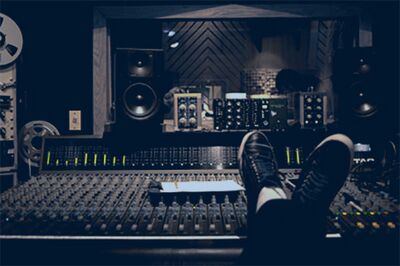How to Use Reference Mixes
From MusicTechWiki
Contents
Overview
A Reference Mix is a track that you know really well and translates (sounds the same) on different systems. The ultimate goal is for you to have your own collection of reference mixes. The more you listen to your reference mixes, on different systems and in different environments, the more valuable your reference mixes will become. Put your files on a portable drive to be ready for opportunities to LISTEN with different monitors and acoustics. Audio files can also be directly imported into any DAW and studied with metering plugins.
Critical Listening
Listening is one of the most important skills you can develop. Critically listening to high resolution audio files is an essential part of the process. Even in this day of streaming services, we still need to have the actual both audio media files on our local drives in order to deeply listen, watch, analyze and edit.
Create a folder called something like Reference-Music and then create subfolders in that folder for various types of reference music.
Audio files for references should be 24 bit lossless files, NOT an MP3 or M4A. At the very least, they should be 16-bit 44.1k WAV, AIF, or FLAC. Downloading a file from YouTube or Soundcloud is not good enough to use as a reference mix.
What to LISTEN for
- One of the MAIN purposes of a reference mix to help our ears determine how much bass, mids and high end should be in our mix
- Low Frequencies 50Hz - 150 Hz. Bass is the most difficult to get right
- Hi Frequencies 8kHz - 12kHz. How bright is your mix?
- Mid Frequencies 1kHz - 4Khz.
- Drums vs. Bass vs. Vocals
- The more times you listen to your reference mixes, on your speakers, headphones and many other speakers (other studios, cars, mobile devices etc.) the more valuable your reference mixes become
What to use for Reference Music
- Check out Billboard charts for the top 10 songs in a given genre
- Choose a wide variety of genres with artists and music that you love
- These should be from many styles and time periods
- It's important to have music produced in different time periods (from the 50's to current) to reference different sonic qualities
- Your personal Reference Mixes Library will be a constant, never ending work in progress
One reason to stay aware of the top hits on Billboard is because these songs represent the latest state of the art audio quality that is available. Even if you don’t love the artist or genre in the top 10, you are listening to productions where money is no object. The people making these records are the BEST at what they do. If you can’t find any music in any genre in the Billboard in the top 10 then rethink your major!
Examples of useful reference mixes
- Mixes that are problematic
- For example, sibilant vocals, harsh midrange, muddy low end etc.
- A mix that you really think is really well done that has BIG low end
- A mix that you think is really well done that has very thin low end
- A mix that you think is really well done that has a bright vocal, that is a little sibilant
- A mix that has a kind of darker, muted vocal
- A mix that has a scooped curve
- Like a lot of lows and highs
- A mix that you think is really well done that you think has a present mid range
- A mix that pushes the volume loudness real far but still works well
- A song that uses an 808 as a bass line is a great idea
Comments from Fab Dupont
Mixing is a highly subjective art form. Give two engineers the same session on the same rig with the same speakers and you’ll get two COMPLETELY different mixes. Actually, if you give one engineer the same session on the same rig with the same speakers on two different days you’re likely to get two different mixes. Even better, if you give the same engineer the same session after he has listened to different kinds of music, the same day, you’ll probably get different mixes too. Try it. It’s fun. And terrifying too, a little bit right? Meaning, which is the RIGHT mix?
There are no RIGHT mixes, as mixes are the product of their environment. (For more existentialist banter please read Jean Paul Sartre). There is today’s mix. And then there is tomorrow’s mix. There is the mix that you like and there is the mix that the artist likes and there is the mix the drummer’s girlfriend likes (most likely the one with louder drums as outlined by aforementioned Jean Paul Sartre in The Critique Of Dialectical Reason). None of them are RIGHT.
We have all come back to the studio in the morning (1pm) and reopened a mix that felt perfectly banging at 2am the night before, only to find that it ranges from bad to horrendous sounding. Why oh why?
Memory vs Taste

That’s because of the interaction between aural memory and taste. Depending on how far ahead you are on your journey to music consciousness, your taste may be stronger or weaker than your aural memory, which itself is getting better and better as you study the art.
If your taste is stronger than your aural memory, you will tend to make mixing decisions that are more independent of what you listened to on your commute this morning than if your taste is still being formed.
If your aural memory takes over, you will make mixing decisions based on what you recently heard (and made you happy) or, depending on how developed your aural memory is, what you THINK what you recently heard (and made you happy) sounds like.
Of course what applies to the commute music applies to your current mix as you are mixing it. There is nothing that sounds more badass than the super clever parallel compression trick you just pulled off on the kazoo solo. If you went too far with that trick because you got excited about the technical prowess of it all, you will get used to that sound and it will influence every mixing decision made down the road. Once you over-compress the kazoo solo (a natural tendency) then you will over-compress everything else - and then you will hate yourself in the morning (1pm).
The way around that is to build a strong taste for tones that you like and that make you happy but it takes time to get there. Years in fact.
In the meantime you can save your bacon by using clever REFERENCING. There is no shame in checking out where you are in your process throughout the day, just like there is no shame is asking for directions on road trips (there is no shame for asking for direction on road trips, right?).
Welcome To The Reference Party

Referencing drives most A-list writing sessions these days, to a fault perhaps, but it’s what allows producers and writers to get to their destination faster. Same goes for mixing. The big question is: what to listen to as a reference??? Good question, thank you for asking.
How does one decide what sounds good if one does not have a reference to choose the reference? It’s like taking a picture of yourself in a mirror taking a picture of yourself in a mirror, etc, etc...
Here is a basic principle
If you mix heavy metal you may not get a lot of cues from a 1960s recording of The Rite Of Spring on Deutsche Grammophon. Consequently most people pick songs in the general style of what they are mixing. And most people pick tracks that have been commercially successful as their reference. That can be a problem, as commercial success in no way guarantees good sound. You have legions of people referencing their mix to questionable sounding music just because those tracks made it on the Billboard Top 10.
I lost track of the number of times when an artist, being confused about how their song sounds coming out of my speakers midway through a mix session, asks to listen to their favorite Kanye/Katy Perry/AC-DC/John Coltrane track only to realize that our stuff is leaps and bound better/fatter/more defined/more present/less crushed etc, etc...
Remember, there is no absolute. Any mix can sound fierce or terrible depending on what you play before or after it and what you had for breakfast that morning. Yes it’s maddening. But it is what it is.
Choosing Wisely

So how does one pick references really?
Gut feeling helps. And then working AT your references makes it good. First choose a song you like for no other reason that ‘you like it’.
Then listen to it everywhere. At your mixing position. On your iPhone. In your car. In a club (you have DJ friend who will play the Rite Of Spring on the earthquake system right?). On a restaurant system. Take notes.
Does it sound good TO YOU everywhere? Yes? That’s a good reference. No? That’s still a good reference as to what not to do.
Whenever you are out and about and you happen to hear a track you like, pay attention to the key elements: vocal vs drums balance, fatness, brightness, impact. Either memorize or write down what you hear. Then listen to that track at home. And compare.
It’s important to do it both ways: Starting at home (conscious decision) then confirming the feeling elsewhere, but also starting in the outside world (falling randomly in love with a track) and confirming the feeling at home. It allows you, over time, to build a library of songs that you more or less know how they sound in various environments and it also allows you to develop a taste for what catches one’s ear in various environments.
So, a year down the road of building your reference palate, when the artist you are working with says “I think I’d like the vocal to be as loud as the new Kesha record.” You can say “Well, of course you do, that’s a great idea, but are you aware it won’t hit very hard in the club if we do that?” because you have heard that Kesha track in the club yourself and that’s when you left the dance floor to go strike a convo with the gorgeous entity at the mezzanine bar. At that point you can also offer a better reference, because you know what hits where, because you have been studying this stuff. Which is your lot in life if you decide to learn to mix records properly.
A Shortcut To Building A Palette?

“But, but but, I don’t have a year. I need to be able to mix hit records NOW!!!!”
Ok, no problem. Understandable. Here’s what to do: What is your favorite mix of YOURS? No really, what is it? You definitely know what it sounds like at your mixing position since you spent a LOT of time making it as perfect as possible.
But have you listened to it EVERYWHERE else? Did you play with other people in the room? Have you watched their reactions? Did you take notes? Even if you don’t like it (even though girlfriend AND mother both say it’s the best thing EVER) it a great way for you to refresh your ears in the middle of a session. You can decide to beat it instead of matching it for example.
“But But, But, I don't know where to start, I have nothing in my folders that is even close enough that I would consider it good enough to even beat!!!!! Give me a starting point!”
Ok, no problem. Here’s a starting point: pureMix MixChecks. There are, as of this writing, 20 articles about specific tracks that have been chosen very carefully to offer the very exact benefits discussed here. Isn’t that wonderful? Get those tracks, read these articles, do the work and you’ll have a much clearer map of what is what, very rapidly.
“But, But, but, there is no Heavy Metal reference on there!!!! It’s no good to me. Please help!”
Ok, no problem.
Here’s another basic principle:
Listen Across Genres
Just like inbreeding did nothing good for the French nobility gene pool back in the day, referencing only the kind of music you make will in time turn up tracks with funny looking noses and eyes too close together.
It is important that your consciousness be broad and that you know a wide range of music, tones and colors, so you can grow beyond the copycat phase and really make a difference in your field. That involves being curious about other species of music and mixing styles whether you like/agree with them or not. So the MixCheck archives should keep you busy for a while until we cover every possible style, including that Revival Polka mix analysis article you have been waiting for.
In Conclusion

Few people mix records without using references because the human brain is highly influenceable and mixing big songs is a rabbit hole of consciousness after the first two hours. Referencing is a lot more important to the process and the final tone of your songs than picking an expensive microphone of compressor (it’s cheaper too). And, you can consciously shape the sound of your music by picking your references carefully. If you want a fat record, listen to fat references, it’s that simple.
One of my very first sessions as a saxophone player was with this rather “original” engineer who had a CD player connected to a stereo pair of always-on return channels on his console. He had a 1000 to 1 compressor inserted on it and the compressor sidechain was fed by the main outputs of the console with the release speed set to 4 or 5 seconds. The result was very interesting. Whenever he played anything from our session, the compressor clamped down on the signal coming from the CD player and we heard our music as expected (it was Zouk music, look it up). But whenever he pressed stop, we would hear the Best Of Elvis album he had running on loop in the CD player slowly come up and gently fill the room. Imagine finishing a take and before you can ask for anything you have Hound Dog coming on. At the time I thought it was both hilarious and stupid. Now I know what he was doing. He had automatic reference music (his reference not ours) in the room at all times. He always knew what the tones he was getting were like, how they would relate to his favorite reference and how they would translate to the outside world. A creative solution to a permanent problem. Plus it was a great way to shut us kids up in between takes.